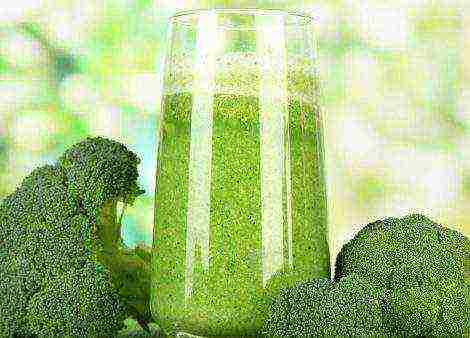Content
- 1 Early varieties of eggplant
- 2 Mid-season varieties
- 3 Eggplant varieties for greenhouses
- 4 Open ground varieties
- 5 The best multi-colored varieties
- 6 The best purple varieties
- 7 The best varieties for the Moscow region
- 8 Bagheera
- 9 Baikal F
- 10 Joker
- 11 City F1
- 12 Sophia
- 13 Fabina F
- 14 Purple Wonder F
- 15 Black handsome
- 16 Black Moon
Eggplant varieties with photos and descriptions
This page contains varieties and hybrids of eggplant for greenhouses and open ground, tall and undersized, early and mid-season, of various colors, shapes and sizes.
Eggplant Diamond
A mid-ripening variety of eggplant for cultivation in the open field. The period from full germination to harvest is 110 - 150 days (depending on the region of cultivation). In the middle lane, it is recommended to plant seedlings in greenhouses and film shelters. The variety is resistant to drought and other adverse weather conditions. Suitable for mechanized harvesting.
The Almaz eggplant variety was included in the State Register and approved for use in the Ural, Far Eastern, Middle Volga, Lower Volga, Central Black Earth, West Siberian and North Caucasian regions.
The bush is compact, 50–55 cm high. The leaves are green, medium in size, broadly oval in shape. Corolla is light purple. The calyx is greenish-purple, without thorns, which makes harvesting easier.
Fruits are glossy, cylindrical, 14.5-17.5 cm long, 3 to 6 cm wide. At biological maturity, eggplants are brown-brown in color. The average weight of the fruit is 100-165 g. The pulp is greenish, dense, not bitter.
Yield eggplant Diamond: 2.1 - 7.5 kg / sq. m.
Advantages of the variety: high and stable yield, unpretentiousness, good taste of fruits, excellent transportability.
Flaws: a large number of seeds in the eggplant, the lower fruits are in contact with the soil.
Eggplant King of the North
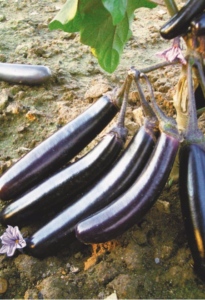
An early ripe hybrid, stable with a stable yield and excellent fruit set. The period from full germination to the first harvest (technical ripeness) is 95–100 days. This hybrid was bred specifically for the harsh climatic conditions of the northern regions of our country, and therefore received this name.
This variety is recommended for outdoor cultivation. Even in Siberia, it is possible to get good harvests in the open field. When grown in greenhouses and greenhouses, the plant is too hot, and there is also the likelihood of being affected by a spider mite.
The bush is over 1 meter high. The stems are bright purple. Fruits are elongated-cylindrical, glossy, black-violet, 25-30 cm long (sometimes 40 cm). White pulp, excellent taste, no bitterness. The peduncle has no thorns.
It is a hybrid of long-term fruiting. Each plant bears up to 10 fruits.
Eggplant yield King of the North: 12 - 15 kg / sq. m.
Landing scheme: 60 x 40 cm.
Dignity eggplant King of the North: cold resistance, unpretentious care, lack of barren flowers, resistance to fungal diseases and temperature extremes.
Flaws: Due to the large size, the eggplants touch the ground, so it is advisable to mulch the soil under them with sawdust or straw.
Your feedback on the King of the North eggplant will help many gardeners evaluate it objectively and decide whether to plant this hybrid or not.
Eggplant Marzipan
Mid-ripening medium ripening period from the company Russian vegetable garden. The period from germination to technical ripeness is 120–125 days. This variety tolerates the heat and drought of the south, but is also great for growing in the northern regions.
For a bush of this variety, support is required, since under the weight of the fruit it can fall to the ground.
The fruits are very fleshy, without bitterness and practically without seeds, have a sweetish aftertaste. The peel is glossy, dark purple in color. The average weight of the fruit is 300-400 grams, the length is up to 15 cm.
Dignity Marzipan varieties: excellent fruit taste, resistance to unfavorable growing conditions.
Yield eggplant Marzipan: 1.5-2.5 kg per plant.
Eggplant Epic
An early ripe classic Dutch hybrid eggplant. Included in the State Register of the Russian Federation in 2008. Recommended for cultivation in the southern regions. The period from planting seedlings in the ground to technical ripeness takes 65 days.
The bush is powerful, tall (90-100 cm), erect, semi-spreading, with high vigor. Stem medium pubescent, with low to medium anthocyanin coloration. Leaves are green, medium in size.
Fruits are glossy, cylindrical, even in shape and size (average length - 22 cm, diameter - 10 cm), dark purple in color, weighing 220 - 230 grams. The eggplant pulp is dense, white, without bitterness and practically without seeds. The calyx is covered with sparsely spaced spines.
Yield eggplant Epic: up to 5.8 kg per sq.m.
Dignity: high yield, resistance to temperature extremes and tobacco mosaic virus, excellent taste of the fruit.
Eggplant Black handsome
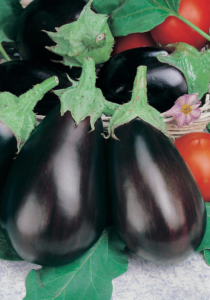
Mid-season eggplant variety for open ground and greenhouses. The period from germination to harvest is 110 - 145 days. The originator of the variety is the Poisk firm. The variety is included in the State Register for the Central Black Earth and North Caucasian regions of the Russian Federation.
Semi-spreading bush, 60-80 cm high, with short internodes. Pubescent stems with anthocyanin coloration. Leaves are green, medium-sized, slightly toothed, with thorns.
Fruits are elongated pear-shaped, glossy, smooth, weighing 110-200 g, 18-20 cm long, purple-black at the stage of full maturity. The pulp is yellowish, tender, without bitterness, practically without seeds. The skin is thin.
Eggplant yield Black handsome: up to 6.5 kg per sq. m.
Advantages of the variety: high yield, disease resistance, unpretentiousness, amicable ripening and high taste of the fruit.
Eggplant Clorinda
Mid-early, super-yielding Dutch eggplant hybrid of high commercial quality for fresh consumption and processing. It can be grown in open ground, under film shelters, in a greenhouse.
Erect bush with short internodes, 90-100 cm high. Leaves are medium-sized, green.
Fruits are oval, up to 25 cm long and up to 12 cm wide, brilliant-black at maturity, glossy, with dense whitish flesh and almost no seeds. No bitterness. Eggplant can weigh up to 1.5 kg.
It is recommended to sow eggplant seeds for seedlings in mid-February, to a depth of 1-1.5 cm. Hybrid eggplant seeds germinate from 7 to 14 days, depending on the temperature, humidity, freshness of the seeds. When planting seedlings in a permanent place, it is advisable to maintain a distance in a row of 25-30 cm and between rows of 50-60 cm.
Yield eggplant Clorinda F1 high.
Eggplant Bourgeois
Early maturing (period from germination to ripening 105-110 days), high-yielding, large-fruited hybrid of eggplant for open ground and film shelters.
The bush is powerful, semi-spreading, of medium height. Leaves are medium in size, green, with notched edges.
Fruits are spherical, smooth, shiny, black-purple in color, weighing 400-500 g, of high taste. The eggplant pulp is greenish-white, tender. These eggplants are recommended for all types of culinary processing.
This eggplant is sown for seedlings at the end of February, then to be planted in open ground when the threat of return frosts has passed. Landing scheme into the ground: 40 x 60 cm.
The value of the hybrid: a combination of early maturity and large-fruitedness, lack of bitterness in fruits, long fruiting period.
Eggplant yield Bourgeois 1.5-2 kg per plant.
Video about eggplant marzipan
Reviews of eggplant varieties
If you are growing any good eggplant varieties that deserve to be ranked in the top 10 best eggplant varieties, please write these varieties. If possible, give them a description and attach a photo of these varieties. What do you think is better eggplant f1 or varietal eggplant?
Your reviews and additions will help our readers choose the best and most productive varieties and hybrids of eggplant for planting.
It is advisable to indicate the growing region in the comments. Thus, we will select the best varieties of eggplant for the Moscow region, Siberia and the Urals, the middle belt, the Northern regions and various regions of our vast country.
Review of eggplant varieties, video
Eggplants Esaul, Ermin, Clorinda, Bibo - a cutaway fruit, the number of seeds in it, taste, thickness of the skin.
Choosing the best for your garden, you automatically choose not only the quality of vegetables, excellent characteristics and taste, but also give yourself the opportunity to use a minimum of labor costs. Eggplant is a vegetable among the varieties of which any gourmet can find to his liking, and no matter what size, color, yield you prefer, there is plenty to choose from. Let's take a look at the best ones.
Early varieties of eggplant
Early eggplants are good not only for the quick ripening of long-awaited vegetables, but also for the opportunity to get a full harvest in the northern regions. If in May you do not have the opportunity to plant eggplants in the ground, and in June night frosts are possible, it is worth choosing early varieties for your garden. Choose hybrids for your garden that have proven themselves among farmers and gardeners.
King of the north
Hybrid with high resistance to frost, subject to hardening of young shoots. Ripeness occurs at 90 - 100 days, but many note that in 70 - 80 days, the fruits can already be fully formed.
It is possible to remove from 3 to 4 kg of even purple cylinders from one plant.
The taste is quite delicate, a small amount of voids even at maximum maturation. Stored at a temperature of 12 - 15 degrees for up to two months, ideal for preparing blanks.
Bibo
This is a white-skinned eggplant with super early ripening. After 60 - 70 days, you will remove up to 15 even and smooth snow-white vegetables weighing up to 500 g from one bush. It is unpretentious, and perfectly pollinates and matures both in the greenhouse and in the ground.
Black handsome
The black handsome variety has an ideal dark shade, the fruits are small, up to 200g, but up to 3 kg can be removed from one root. After 70 - 80 days, it gives a friendly harvest, but it is worth protecting from the first frosts, it requires additional shelter.
Mid-season varieties
These eggplants are best used in regions where there are no unexpected frosts, or grown in a greenhouse. Due to the longer ripening period than in early ripening ones, you should carefully monitor the temperature in the greenhouse. The more stable the temperature and humidity, the richer the crop will be.
Albatross
If you like teardrop-shaped eggplants, round, fleshy, without voids, then this is your option. A variety for fresh consumption, conservation and long-term storage. Easy to transport, has a high keeping quality, this has become the main reason for choosing among farmers.
Diamond
One of the most favorite eggplant of gardeners in the middle lane. It is considered a dwarf bush, but very branchy, formed in the form of a ball. Decorative. Aging period up to 80 days. You can get up to 8 kg from one bush. Fruit weight up to 180g. The formation of flowers takes place from June to August, and the fruiting is therefore long.
Marzipan
Connoisseurs of the delicate and tasty pulp of this eggplant prefer it not only for this reason. Ripens in 110 - 120 days, has a beautiful pear-shaped shape, deep purple hue.
Eggplant varieties for greenhouses
High-yielding varieties grow well in greenhouses, they require care, but respond to it with amicable and good fruiting.Stable temperature and humidity allow you to choose tall plants - from each such bush, you can remove from 5 to 12 kg of vegetables.
Robin the Hood
A mid-season hybrid, requires the formation of a bush, but has a low growth of up to 60 cm. The plant has thorns. Pear-shaped, rounded fruits with low bitterness, ripening at 90 days. Medium keeping quality, for all types of canning and cooking.
 Description of the variety Robin Hood
Description of the variety Robin Hood
Policeman
Tall, up to 240 - 260 cm, ripens up to 120 days from the time of planting. Fruits ranging in size from 20 to 35 cm, yield - up to 9 kg. Requires the formation of a bush, it is enough to leave 2 stems, on which up to 15 fruits ripen at the same time.
Excellent taste for both fresh and salted consumption.
It can be stored fresh for up to 2.5 months, loses its presentation a little, dries out, but the taste remains.
Sophia
A late-ripening variety with large fruits. Ripe fruits reach 30 cm and weigh up to 900g. The bush is up to 150 cm high, forms itself, but pinching is required. Up to 17 kg can be removed from one plant. very dense purple fruits. Perfectly stored and transported, the shelf life is the highest among all varieties with such a productivity - up to 3 months.
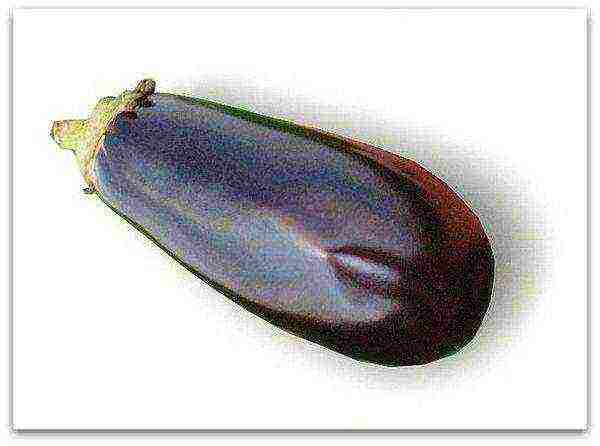 Eggplant Sophia
Eggplant Sophia
Open ground varieties
If you plan to grow your eggplant outdoors, suitable frost-resistant varieties are essential. In the middle lane, even the most patient vegetable for temperature changes requires shelter for the period of night frosts. Only zoned hybrids are ideal for a greenhouse.
Vakula
Patient enough to temperature changes, you can plant seedlings at the end of May. Height up to 120 cm, has a strong and dense stem. Pinching is not required, the bush forms itself. Up to 8 kg of eggplant can be removed from one bush.
Bull heart
Does not tolerate spring frosts, therefore, plant in open ground after their end. Rounded fruits weighing up to 300 g., Bush up to 80 cm., Yield about 8 - 12 kg. Unpretentious in agricultural technology, but does not tolerate overflow.
Alekseevsky
One of the best outdoors. The height of the bush is up to 70 cm, very branchy, fruits up to 150g, but in one season it is possible to collect up to 9-10 kg. A garter is required, as the bush is very fragile.
The best multi-colored varieties
The white-skinned varieties were bred in order to get rid of the bitterness, which is contained precisely in the coloring enzyme. Eggplants of other colors were obtained by crossing.
Swan
One of the best white eggplants. It has not only white skin, but also flesh. Can be grown both in soil and in a greenhouse. The height of the bush is up to 70 cm., The weight of the fruit is up to 250 g. The yield of one plant is up to 6 kg.
Icicle
Unusual due to its shape, which is why it is attractive. Bush up to 80cm. Fruits up to 300g. Up to 5 kg can be removed from one bush.
Flamingo
The name speaks for itself - beautiful pink, curved fruits weighing up to 40hg. They are in time for 130 days. Shrub up to 180cm, spreading and high-yielding. Up to 16 kg can be harvested from one plant.
Purple Haze
Dark pink fruits weighing up to 180 g, ripen, on average, in 120 - 130 days. Bush up to 150cm, branched. It is afraid of frost; in a greenhouse, up to 5 kg can be removed from one plant.
Yoga
Unusually - green fruits, reminiscent of curled corn. Each weighing up to 250g., Up to 20cm long. The bush is up to 80 cm, semi-spreading, does not require formation. The pulp and rind have no bitterness.
Emerald
Bright green fruits weighing up to 300 g., Ripen on average up to 100 days. The plant tolerates temperature extremes and mild drought. From one root in 120 days, you can get up to 5 kg of vegetables.
Chinese lantern
In 80 - 110 days after sowing, at 70 cm, unusual eggplants begin to turn red in the bush. Unusual bright color and shape makes them look like decoration. Weight up to 180g, yield - up to 3 kg per plant.
The best purple varieties
Even the fact that new bright colors of the vegetable with low bitterness appeared did not distract from the standard purple favorites.Among them, the leading varieties are:
King of the north
Resistant to frost, technical ripeness for 90 - 100 days, but can be removed for 70 - 80 days. Up to 4 kg of even purple, very beautiful fruits are removed from the bush.
Purple miracle
Hybrid. It tolerates drought patiently, but it is necessary to use a lot of water one time. The bush is up to 90 cm high. Beautiful elongated fruits, weighing up to 250g. Maturation at 90 - 115 days. From one plant, you can get up to 8 kg of eggplant.
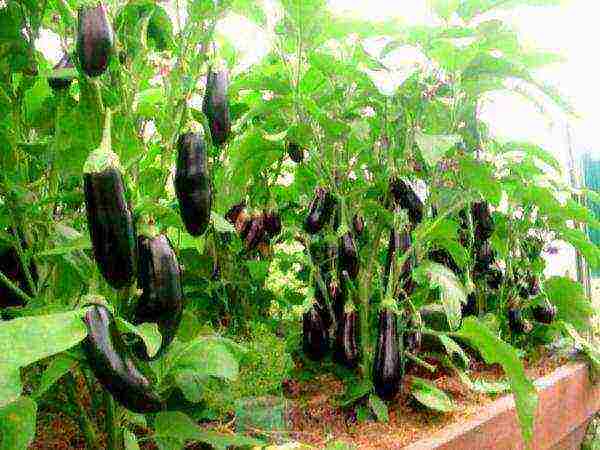 Purple miracle
Purple miracle
Diamond
Dwarf variety. Height up to 50 cm, but the bush is very branched. Looks very decorative, in the form of a ball, does not require shaping. Ripeness for 80 days. Fruits up to 180 - 200g.
During the season, you can get up to 8 kg of beautiful bright purple fruits.
The best varieties for the Moscow region
The middle lane is a rather mild climatic zone, but late summer and early autumn do not allow late-ripening varieties to fully ripen. Greenhouses help with this, but it is still worth choosing early and mid-season varieties.
These varieties will give an excellent harvest and bring a minimum of hassle:
- King of the north. Will give an excellent harvest in the absence of frost in early summer. It proved to be excellent both in greenhouses and in the ground;
- Black Prince. It is worth choosing it not only because of its decorative effect. The rich purple color hides the tender pulp without bitterness, and from one bush it is possible to get fruits up to 8 kg.;
- Sophia. Even when planting in the ground, and covering in the first week, you will receive up to 15 - 17 kg of large, up to 900g per season. Eggplant.
- Albatross. Mid-season, but ripening early enough. On day 90, the first fruits can be removed. Beautiful cylindrical shape and delicate taste. Patient about drought;
If you dream of a friendly and high harvest, minimal labor costs and pleasing to the eye vegetables, you should choose seeds zoned for your area, provide proper care, and do what you love with pleasure.
Let's look at the best varieties of eggplant for open ground and their description with features and photos. There are early, mid-season and late varieties, those that are high yielding and have an atypical color. Therefore, when choosing, it is worth considering various points, including the ripening time, yield, the complexity of growing, and the like.
How to choose a variety according to the ripening period?
In greenhouses, late varieties of eggplant are more often planted, in the open field - early ones. The climate also plays an important role in the choice of seeds, because the colder it is, the earlier the eggplants should ripen.
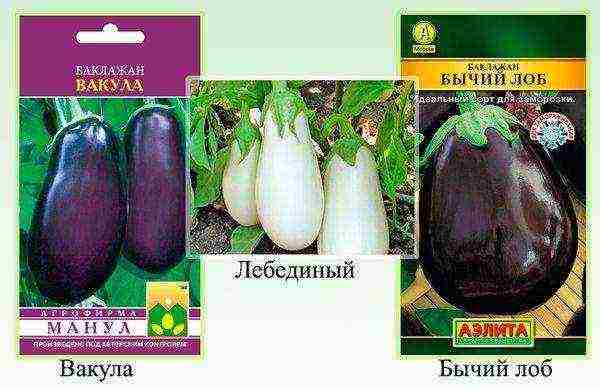
Eggplant varieties by ripening period
- The early varieties yield very early harvests and are harvested after a maximum of 100 days. Thanks to this, you can not wait most of the summer to feast on your favorite vegetable. These include: "Vakula", "Galina F1", "Nadir", "Negus", "Maria", "Lilac fog", "Alekseevsky".
- Mid-season varieties ripen in 105-135 days on average. This category includes "Swan", "Comet", "Surprise", "Albatross".
- Late varieties of eggplant ripen no earlier than 140 days or more. Their advantage is rich taste and pleasant aroma. Late varieties include "Bull's forehead", "Black handsome", "Mishutka".
What are the best yielding varieties of eggplant?
Eggplant varieties are very popular, but do not forget that they need more care. At least high-quality props and additional feeding will help the vegetable develop.
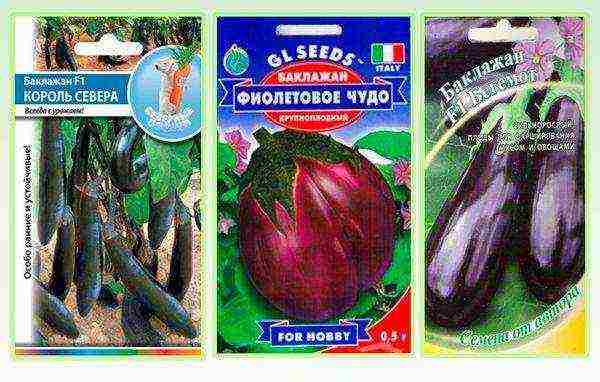
The best yielding varieties of eggplant
- King of the North F1"Is considered one of the most productive species. You can harvest up to 15 kg of eggplant per square meter! The hybrid has oblong fruits of a dark purple color, the flesh is white, not bitter.
- "Purple miracle"- an early variety, 14 kg of vegetables are harvested from a square meter. Purple eggplant, very tasty and versatile in terms of use.
- «Hippo F1»Recommended for greenhouse cultivation. It is in such conditions that 14 kg of eggplant can be collected from one square meter.On the street, the yield will drop to 7-9 kg.
- "Joker" gives from a bush per season within 60 pieces of eggplant. The vegetable is purple. The taste is pleasant, without bitterness. The plant can grow both outdoors and in a greenhouse.
- "Nadir" - a high-yielding variety that allows you to collect 7 kg of vegetables per square meter per season. Variety purple with thin skin, fruit weight up to 200 grams.
- "Negus" differs in many ways. The yield per square meter is 7 kg or more. Grows in a small bush, up to 50 cm.
- "Diamond" has a dark skin and light, delicate flesh. Fruits are oblong, up to 17 cm long. Productivity - 5 kg per square meter.
How to choose a variety by color?
Today, an incredible number of varieties of eggplant are known and new varieties appear every year. The first thing that catches your eye at the sight of each individual variety is the color of the vegetable.
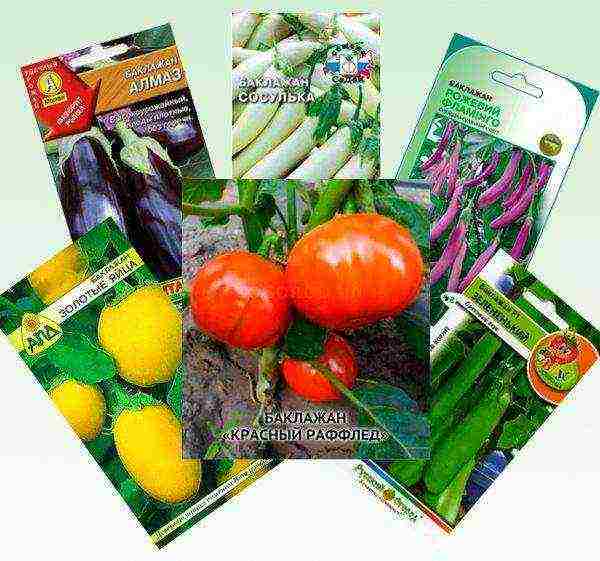
Variety of eggplant varieties by color
- Of the purple beauties, one should first of all consider the popular "Diamond" and "Black handsome". The first has a fruit weight of 200 g, the second - 250-300 g. At the same time, the eggplants of these varieties do not have bitterness, the pulp is dense, well stored. In addition, you can pay attention to the "City F1", "Banana", "Bourgeois", "Albatross", Black Beauty, "Black Moon".
- White eggplant varieties are popular for their pleasant taste without bitterness with a hint of mushroom. The plus is that there are few seeds in the vegetable. They are unpretentious, grown in areas with different types of soil. Of the white varieties, the best quality characteristics are "Icicle", "Iceberg", "Swan", "Ping-pong", "Pelican", "Taste of mushrooms". The latter, in addition to the taste of mushrooms, also has a typical mushroom aroma.
- Lilac-pink eggplants are still a rarity on store shelves and market squares, but you can grow a curiosity without any problems on any site. High germination rates are distinguished: "Pink Flamingo", "Matrosik", Bumbo "," Lilac.
- Green eggplants only seem unripe; this variety can please even gourmets with its taste. "Zelenky" has a mushroom flavor, and its shape looks more like a pear, the maximum weight is 300g. "Emerald" has a delicate pulp, without bitterness. Grown in open ground and greenhouses, unpretentious.
- Red, orange and yellow eggplants are very rare, even as seeds. They are distinguished by a bitter taste, they contain a lot of carotene, and outwardly they are very similar to tomatoes. The most common types are "Golden Eggs" and "Red Ruffled", other varieties are mainly grown in Holland, Turkey, Mexico, Africa.
The best varieties for open ground and greenhouses? 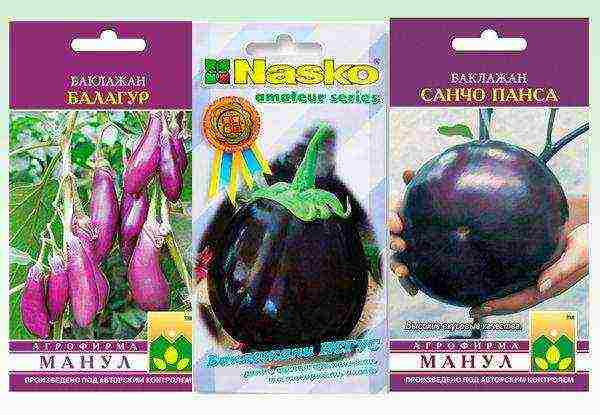
The best varieties of eggplant for open ground and greenhouses
In the open field, early, hardy eggplant varieties are most often grown, which include:
- "Negus" - the ultra-early variety ripens in 70-90 days, depending on the quality of care. Eggplants are well stored, withstand long-term transportation. The vegetable itself is small up to 300 grams.
- "Vakula" gives 12.5 kg of vegetables from one square meter. No more than 5 plants are planted on such an area. It gets along in any climate. Without fail, a young plant is tied up, since individual eggplants can reach 400 g!
- "Joker" - a high-yielding variety. One plant can harvest 50-80 fruits per season. A lot of weight requires additional supports so that the fragile stem does not break.
- Sancho Panza the eggplant is distinguished by its record size and belongs to the high-yielding varieties. One spherical vegetable can reach 900 g! The variety is livable, not afraid of mosaics and spider mites. Medium ripening.
Not all varieties are suitable for growing in a greenhouse. Such plants should be able to get along without an abundance of sunlight and fresh air. These include: "Violet Miracle F1", "Bibo F1", "Baikal F1", "Behemoth F1".Eggplants of these varieties are distinguished by high livability in greenhouses, productivity and excellent taste.
Ten years ago, eggplants were a rarity in summer cottages in the middle lane. But thanks to the work of breeders and the widespread use of greenhouses, this culture has become popular and loved. We will tell you about the best varieties for indoor use.
Greenhouse growing of eggplants is the only way to grow "blue" ones in the middle lane. Southern culture loves warmth, abundant watering and needs special protection from diseases and pests. Usually hybrids and varieties that are more hardy than usual are recommended for greenhouses.
Most often, early and mid-season varieties are grown in greenhouses. Experienced gardeners also prefer low-growing plants, since in this case the eggplants in the greenhouse do not need to be tied up additionally. What varieties of eggplant for greenhouses can you recommend to both beginners and experienced gardeners?
Bagheera
This variety is distinguished by its early maturity and small, compact bushes with abundant foliage. Fruits are oval, dark purple with a glossy sheen. The pulp is practically not bitter, and the taste pleases with its richness and depth. The bushes of this variety are grown using a low-volume technology (growing in small containers, where peat, vermiculite, etc. are used as a substrate), therefore it is recommended for small greenhouses. Ripe fruits are perfectly stored and do not lose their presentation for a long time. High yield and resistance to various diseases are two more compelling arguments for positive reviews about the variety.
| Appointment | Productivity (kg / sq.m) | Fruit weight (g) | Maturation (days) | Pulp color |
| 10-12 | 280-350 | 100-110 | Greenish white | |
Baikal F
The bush of this mid-season hybrid grows to an impressive size, reaching 1.2 m in height. The plant is recommended for growing in all types of greenhouses. The fruits are pear-shaped, medium-sized, dark purple in color with a glossy surface. Medium density pulp without bitterness. Excellent caviar is obtained from the fruits, they are pickled, salted, stewed and fried. Eggplants Baikal F1 are quite resistant to various diseases and, at the same time, are unpretentious in cultivation.
| Appointment | Productivity (kg / sq.m) | Fruit weight (g) | Maturation (days) | Pulp color |
| 6-8 | 320-350 | 100-110 | Greenish | |
Joker
This type of eggplant has an unusual type of fruiting - carpal. Up to 4-6 fruits are formed on one bush, and from 50 to 100 fruits can be collected from one bush. The non-standard type of ripening also led to the unusual shape of the fruits - they are elongated, oval, "acidic" bright purple color. Their peel is rather thin, and the flesh has a good taste. The variety is ideal for a greenhouse - the bushes do not exceed 1.3 m in height. Plants perfectly resist the tobacco mosaic virus and many other diseases.
| Appointment | Productivity (kg / sq.m) | Fruit weight (g) | Maturation (days) | Pulp color |
| 6-8 | 80-130 | 85-100 | White | |
Policeman F1
Large and powerful spreading bushes of this plant will not leave anyone indifferent. They reach 3 m in height and delight with cylindrical and dark purple colored bush fruits. The pulp is dense, it does not boil during stewing and frying. To get such large fruits, you need to be patient, because the variety is late. But ripe eggplants are stored for a long time and are suitable for any type of transportation. The hybrid is resistant to the tobacco mosaic virus and some other diseases, especially if you do not violate agricultural practices and grow it in a greenhouse.
| Appointment | Productivity (kg / sq.m) | Fruit weight (g) | Maturation (days) | Pulp color |
| 7-8 | 400-500 | 120-135 | Greenish | |
Sophia
This late-ripening variety is loved for the fact that it is equally comfortable everywhere - both in the open field, and under a film cover, and in a greenhouse. Ideal for owners of small areas. The bushes are semi-spreading, low, covered with large, thick pear-shaped fruits. Fruit color is black and purple.They perfectly tolerate adverse weather conditions. The pulp is firm and without bitterness. Disease resistance is low, so prophylactic spraying and proper care are required.
| Appointment | Productivity (kg / sq.m) | Fruit weight (g) | Maturation (days) | Pulp color |
| 7,5-8 | 700-900 | 135-150 | White | |
Fabina F
An ultra-early hybrid of eggplant grown in a greenhouse. Semi-spreading bushes, medium height. Fruits are cylindrical, dark purple in color, with a bright glossy sheen. They do not grow too large, but they have a characteristic mushroom taste, which makes it possible to prepare many interesting dishes from them, including Caucasian ones. The fruits are well stored and do not lose their presentation for a long time. The hybrid is quite resistant to many diseases (especially to verticillosis), the plant rarely damages the spider mite.
| Appointment | Productivity (kg / sq.m) | Fruit weight (g) | Maturation (days) | Pulp color |
| 5-7 | 180-210 | 70-90 | Whitish green | |
Purple miracle F
One of the most famous and widespread hybrids, which is loved by summer residents for its versatility. The plant feels great both outdoors and in a greenhouse. Surprisingly, at all stages of growth, bushes and stems are hardly susceptible to daylight hours and sunlight, which allows them to be grown in the regions of the Far North and Siberia. Fruits are dark purple in color, elongated, fusiform, with a smooth and shiny skin. There is no bitterness in the pulp, so the Purple Miracle eggplants are suitable for any kind of processing. The plant's resistance to diseases is average, but complex (immediately to many infections).
| Appointment | Productivity (kg / sq.m) | Fruit weight (g) | Maturation (days) | Pulp color |
| 6-8 | 250-300 | 95-100 | Greenish white | |
Black handsome
A mid-season high-yielding variety respected by all greenhouse owners. The plant is compact, emerges very actively. The fruits located in its lower part have a rare feature - they ripen regardless of weather conditions and even with a small amount of sun. They are cylindrical, with a color that can vary from deep purple to almost black. The surface of the fruit is smooth, with a glossy sheen. The pulp is tender and tasty. The variety is resistant to crop diseases.
| Appointment | Productivity (kg / sq.m) | Fruit weight (g) | Maturation (days) | Pulp color |
| 10-12 | 200-250 | 110-115 | Light green | |
Black Moon
It is a mid-season variety with small bushes and dense, wide fruits that stretch slightly as they ripen. Eggplants are usually dark purple in color, with a sparkling glossy sheen. The pulp is practically not bitter, it has good taste. Therefore, the fruits of this variety are deservedly popular with housewives and admirers of healthy eating. The bushes require a lot of light and moisture, but if these conditions are met, they are not afraid of any diseases.
| Appointment | Productivity (kg / sq.m) | Fruit weight (g) | Maturation (days) | Pulp color | |
|
5-7 |
200-220 |
120-140 |
Dark white | ||
By choosing one of these varieties, you can always diversify your menu by adding fresh and delicious eggplants to it. However, the list of recommended varieties is not limited to those presented above. Experiment and share your results in the comments.


